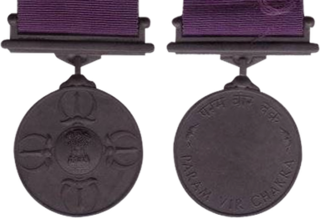
The Param Vir Chakra (PVC) is India's highest military decoration, awarded for displaying distinguished acts of valour during wartime. Param Vir Chakra translates as the "Wheel of the Ultimate Brave", and the award is granted for "most conspicuous bravery in the presence of the enemy". As of January 2018, the medal has been awarded 21 times, of which 14 were posthumous and 16 arose from actions in Indo-Pakistani conflicts. Of the 21 awardees, 20 have been from the Indian Army and one has been from the Indian Air Force. Major Somnath Sharma was the first recipient. A number of state governments of India as well as ministries of the central government provide allowances and rewards to recipients of the PVC.
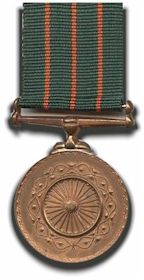
The Shaurya Chakra is an Indian military decoration awarded for valour, courageous action or self-sacrifice while not engaged in direct action with the enemy. It may be awarded to civilians as well as military personnel, sometimes posthumously. It is third in order of precedence of peacetime gallantry awards and comes after the Ashoka Chakra and the Kirti Chakra. It precedes the Yudh Seva Medal.[total recipients 2094]. [total awarded posthumously is 677].
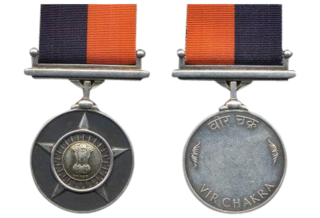
The Vir Chakra is an Indian wartime military bravery award presented for acts of gallantry on the battlefield, on land or in the air or at sea.

The KirtiChakra is an Indian military decoration awarded for valour, courageous action or self-sacrifice away from the field of battle. It may be awarded to civilians as well as military personnel, including posthumous awards. It is the peacetime equivalent of the Maha Vir Chakra. It is second in order of precedence of peacetime gallantry awards, comes after Ashoka Chakra and before Shaurya Chakra. Before 1967, the award was known as the Ashoka Chakra, Class II.
Kamlesh Kumari Yadav was an Indian constable who served with the Central Reserve Police Force (CRPF) and a recipient of the Ashoka Chakra, the highest possible award conferred during peacetime by the Republic of India. Kamlesh Kumari died on 13 December 2001 after successfully preventing terrorist gunmen and a terrorist suicide bomber from reaching Parliament during the 2001 Indian Parliament attack.
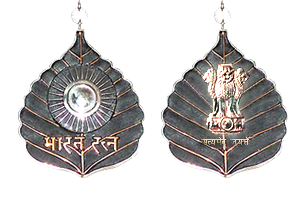
The Indian honours system is the system of awards given to individuals for a variety of services to the Republic of India. The categories of awards are as follows:
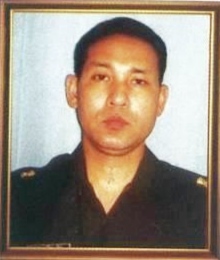
Major Laishram Jyotin Singh, AC was an Officer in the Army Medical Corps of the Indian Army, who died fighting a suicide bomber during the attack on the Indian Embassy in Kabul. Major Singh was awarded the Ashoka Chakra, the highest peacetime gallantry award in the Indian Armed Forces on 26 January, 2011.

Naib Subedar Chuni Lal AC, VrC, SM was an Indian Army soldier of The Jammu and Kashmir Light Infantry. He was born in Bhaderwah, and basically from Gandhari Paddar and lived in Bhara village with parents Shanker Dass and Shakuntala Devi in Doda district of Jammu. Decorated with Vir Chakra and Sena Medal (Gallantry), JC-593527, Lal was killed in action on 24 June 2007 in a militant flush-out operation in Kashmir's Kupwara sector. These militants, all of whom were also shot dead, were trying to cross the Line of Control (LoC) and enter Indian territory. The success of this militant flush-out operation, which claimed his life, earned him the highest peacetime military decoration awarded for valor, courageous action or self-sacrifice away from the battlefield, the Ashok Chakra. He is the highest decorated soldier of the Indian Army of all time, honored with Sena Medal, Vir Chakra and Ashok Chakra.

Havildar Rajesh Kumar, AC was a Non Commissioned Officer (NCO) of Indian Army who was awarded India's highest military decoration Ashoka Chakra.

Subedar Sujjan Singh Yadav, AC was an Indian Army Junior Commissioned Officer (JCO) with the 13th Battalion of the Kumaon Regiment. He was awarded the highest peace time gallantry award Ashoka Chakra posthumously for his action in Operation Rakshak in Kupwara, Jammu and Kashmir.

Naik Neeraj Kumar Singh, AC was a Non Commissioned Officer (NCO) in the Indian Army who was posthumously awarded the Ashok Chakra, the country’s highest peacetime military decoration on 26 January 2015. He had enlisted in the 13th battalion, Rajputana Rifles and was serving in the 57th battalion Rashtriya Rifles when he was killed in action.

Havildar Hangpan Dada, AC was a soldier in the Assam Regiment of the Indian Army. He was posthumously awarded the Ashoka Chakra, India's highest peacetime military decoration in August 2016.

Major General Cyrus Addie Pithawalla AC, VSM, is a former General officer of the Indian Army. He was awarded India's highest peacetime decoration for gallantry, the Ashok Chakra, in 1981, and by virtue of this is one of the most decorated flag officers in the history of the Indian Armed Forces.

Havildar Bachittar Singh, AC was a soldier in Indian Army who was posthumously awarded the highest peacetime military decoration Award "Ashoka Chakra", for conspicuous bravery, indomitable spirit and supreme sacrifice; becoming the first Indian to receive this gallantry award.
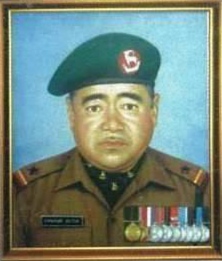
Naib Subedar Chhering Mutup, AC is a retired Junior Commissioned Officer (JCO) with the Ladakh Scouts who was awarded the Ashoka Chakra, India's highest peacetime military decoration.
Subedar Major and Honorary Captain Mahendra Singh, KC, SM is a decorated Indian Army Junior Commissioned Officer (JCO) of 9 Para SF. During an operation, he was paralysed on one side of his body.
Assistant Sub-inspector Babu Ram, AC (1972–2020) was a Police Officer of the Special Operations Group (SOG) Srinagar, who was awarded the highest peace time gallantry award, the Ashok Chakra.















